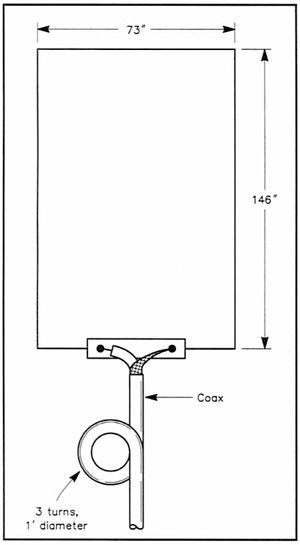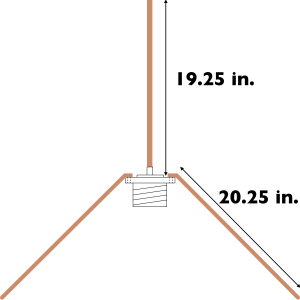It is known that a single dipole antenna tuned neslishkom has a high gain. But if you use two of these antennas connected a phased power line, then we can increase the gain of the antenna. The result is an antenna system comprising two types of dipole antennas, is reminiscent of the Latin letter h and with the name of "lying h". This antenna (lying h) feeding points has high input impedance and it soglosovat to the power supply line of arbitrary length requires use quarter wave transformer. Antenna type "bream h" has exactly takuyuzhe radiation pattern in the horizontal plane as the normal dipole antenna. But the radiation pattern in the vertical plane in the investigation narrows the location of two dipoles of each other and that this expense and get a win to be reinforced. But this antenna system has its drawbacks - namely, suspension height. Necessary to lower the dipole antenna "lying h" was at the height of not less than L / 2 + height of the top of the dipole. The approximate gain of the antenna "lying h" 5-6 dB! And it is much more than a single dipole. The figure shows the dimensions of the antenna "lying h" for three ranges of 14, 21, 28 MHz. As the supply line used by the resonant power line, it Is located horizontally to a measure on the longer L / 2. For this it is necessary to use another mast. Radiation pattern is the range of frequencies used.
Collection of Amateur Radio Antenna Projects and informations
Sunday, December 29, 2013
Vertical delta-loop antenna
This month I would like to share an idea from my sketchpad with you. I am planning to build a vertical delta-loop antenna for 20 meters. The reasons for choosing this design:
OZ1BXM Lars Petersen
- My favourite HF band is 20m
- Delta-loops for 20m are manageable in size
- Loops are quiet on receive
- Vertically polarized loops are well suited for DX
Delta-loop overview.
My choise of shape will be version D because if offers a low radiation angle, which is necessary for DX. The sketch below shows how I plan to build the antenna:
Delta-loop antenna for 20m.
A delta-loop antenna with ATU was described by WB8IMY and published in QST May 2002: One Stealthy Delta. This article is worth studying if you consider constructing a loop antenna.OZ1BXM Lars Petersen
Building a 2m quarter-wave ground-plane antenna
The first antenna that you should consider building is the quarter-wave ground-plane antenna for the 2m band. They are very easy to build and will perform better than the antennas that come with most handhelds.
The quarter-wavelength, ground plane antenna is made up of one vertical element, called the driven element, and four radials. The radials make up the ground plane. An easy way to make this antenna is to use an SO-239 coax connector. The driven element is soldered directly to the center conductor, while the four radials are connected to the four holes in the connector’s flange. See the figure at right.
Now, let’s calculate how long the elements should be. Since the wavelength of a radio wave is equal to 300/f (MHz), one quarter wavelength will be equal to 75/f (MHz). At 146 MHz, therefore, the length of the driven element is:
75/146 = .51 m
In practice, we have to make one more adjustment. Because a radio wave travels more slowly in a wire than it does in free space, the wavelength will actually be about 5% less in a wire than in free space. So, we multiply the wavelength in free space by .95 to get the length of the driven element:
.51m x .95 = .49m = 19.25 inches
The radials should be about 5% longer than the driven element. This isn’t really very critical, so if you make them 20.25 inches long, the antenna will work just fine.
You should make the elements out of a stiff wire. 12 AWG copper wire will work for experimentation purposes. Welding rod might be better for a more permanent antenna.
You need to solder the 19.25-in. driven element to the solder cup of the center conductor of the SO-239 connector. Attach the radials to the holes in the flange of the SO-239 connector with nuts and bolts. You can also use these nuts and bolts to mount the antenna to some kind of bracket. Bend the radials out to a 45-degree angle, connect a coax cable to it, and start having fun
10m loop antenna.
Here’s something interesting about the loop antenna and folded dipole antenna. If you read my blog, you’ll remember that I recently put up a 10m loop antenna.
 Well, this loop has a full wavelength of wire and is twice as high as it is wide. In this configuration, the antenna has a feedpoint impedance of 50 ohms.
Well, this loop has a full wavelength of wire and is twice as high as it is wide. In this configuration, the antenna has a feedpoint impedance of 50 ohms.
If you take that same wavelength of wire and configure it so that the height is very small with respect to the width, you have a half-wavelength, folded dipole. In this configuration, the feedpoint impedance is about 300 ohms.
Back in the day, hams used this to make folded dipoles out of 300-ohm twinlead, the same kind of wire used to connect TVs to external antennas. Not only did the twinlead serve as the antenna wire, but it also served as the feedline, and because this twinlead was mass-produced, it was relatively inexpensive. To match the 300-ohm impedance to a transmitter, you did need some kind of transmatch or a balun, but overall, this type of antenna works very well and was cheap to build.

If you take that same wavelength of wire and configure it so that the height is very small with respect to the width, you have a half-wavelength, folded dipole. In this configuration, the feedpoint impedance is about 300 ohms.
Back in the day, hams used this to make folded dipoles out of 300-ohm twinlead, the same kind of wire used to connect TVs to external antennas. Not only did the twinlead serve as the antenna wire, but it also served as the feedline, and because this twinlead was mass-produced, it was relatively inexpensive. To match the 300-ohm impedance to a transmitter, you did need some kind of transmatch or a balun, but overall, this type of antenna works very well and was cheap to build.
Homemade Yagi Antenna
One of my favorite things to do is talk with other ham radio operators through satellites or the International Space Station (ISS). To do this, I stand on a rooftop and tune a handheld multiband radio while tracing the orbit of a satellite or the ISS with my homemade yagi antenna.
Orbiting satellites such as AO-51, SO-50, and AO-27 act as repeaters, relaying signals from low-power transceivers like mine back to hams elsewhere on the planet. So if you know where to aim the antenna, you can communicate around the world via space. The ISS also has a repeater, and occasionally, when we’re lucky, the astronauts themselves exchange transmissions to communicate with hams on the ground.
To listen to these signals from space, you don’t have to be a licensed ham radio operator, or even stand on the roof. You can do it in your own backyard with an off-the-shelf UHF FM radio. The whip antenna on the radio might let you hear satellites and the ISS, but you’ll get far better reception by making your own yagi antenna, which takes about an hour and costs less than $25 (not including the cost of your radio) using materials from your local hardware store.
http://makezine.com/projects/homemade-yagi-antenna/
Orbiting satellites such as AO-51, SO-50, and AO-27 act as repeaters, relaying signals from low-power transceivers like mine back to hams elsewhere on the planet. So if you know where to aim the antenna, you can communicate around the world via space. The ISS also has a repeater, and occasionally, when we’re lucky, the astronauts themselves exchange transmissions to communicate with hams on the ground.
To listen to these signals from space, you don’t have to be a licensed ham radio operator, or even stand on the roof. You can do it in your own backyard with an off-the-shelf UHF FM radio. The whip antenna on the radio might let you hear satellites and the ISS, but you’ll get far better reception by making your own yagi antenna, which takes about an hour and costs less than $25 (not including the cost of your radio) using materials from your local hardware store.
http://makezine.com/projects/homemade-yagi-antenna/
Subscribe to:
Comments (Atom)



